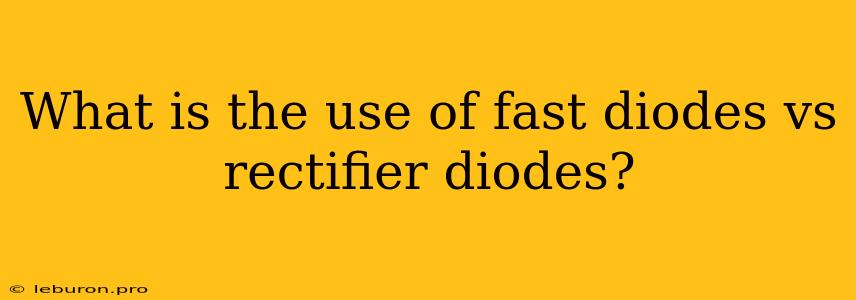Diodes are essential components in electronic circuits, acting as one-way gates for electrical current. While both fast diodes and rectifier diodes perform this fundamental function, their unique characteristics make them suitable for different applications. Understanding the differences between these two diode types is crucial for engineers and hobbyists alike, enabling them to select the optimal diode for their specific circuit needs. This article delves into the world of fast diodes and rectifier diodes, exploring their individual properties, applications, and the key factors that differentiate them.
The Fundamental Role of Diodes
Before we delve into the specifics of fast diodes and rectifier diodes, let's briefly recap the basic function of a diode. A diode is a semiconductor device with a p-n junction, a boundary between a p-type semiconductor material and an n-type semiconductor material. This junction acts as a one-way gate for electrical current. When a positive voltage is applied to the p-side (anode) and a negative voltage to the n-side (cathode), the diode is forward biased, allowing current to flow. Conversely, when the diode is reverse biased, with a negative voltage applied to the p-side and a positive voltage to the n-side, the diode blocks current flow.
Fast Diodes: Speed and Efficiency
Fast diodes, also known as high-speed diodes, are designed for applications where rapid switching speeds are critical. They exhibit significantly shorter reverse recovery time compared to rectifier diodes. This parameter measures the time it takes for the diode to transition from a conducting state to a blocking state when the voltage across it changes from forward bias to reverse bias.
Characteristics of Fast Diodes:
- Fast Switching Speed: The most defining characteristic of fast diodes is their ability to switch between on and off states quickly, typically with a reverse recovery time in the nanoseconds or picoseconds range.
- Low Forward Voltage Drop: Fast diodes often have a lower forward voltage drop compared to rectifier diodes, which means less power is wasted as heat during operation.
- High Current Capacity: Some fast diodes are designed to handle high current levels.
- Lower Reverse Leakage Current: Fast diodes typically exhibit lower reverse leakage current, ensuring minimal current flow when reverse biased.
Applications of Fast Diodes:
- High-Frequency Circuits: Fast diodes are essential in circuits operating at high frequencies, such as radio frequency (RF) and microwave circuits.
- Switching Power Supplies: They are crucial in switching power supplies, where fast switching speeds are required for efficient power conversion.
- Data Transmission and Communication Systems: Fast diodes find applications in high-speed data transmission and communication systems, including fiber optic transceivers.
- Logic Circuits: In digital logic circuits, fast diodes contribute to the efficient and reliable operation of logic gates and other digital components.
Rectifier Diodes: The Workhorses of Power Conversion
Rectifier diodes, as their name suggests, are mainly used for converting alternating current (AC) to direct current (DC). They are often found in power supplies, where they rectify the AC voltage, effectively blocking the negative portion of the AC waveform. While not as fast as fast diodes, rectifier diodes are designed for handling high current and voltage levels.
Characteristics of Rectifier Diodes:
- Slower Switching Speed: Compared to fast diodes, rectifier diodes have a longer reverse recovery time, typically in the microseconds range.
- High Forward Voltage Drop: Rectifier diodes often exhibit a higher forward voltage drop compared to fast diodes, resulting in slightly lower efficiency in power conversion.
- High Current and Voltage Handling Capability: Rectifier diodes are designed to handle high current and voltage levels, making them suitable for applications involving significant power conversion.
- High Reverse Blocking Voltage: They are designed to withstand high reverse voltages without breakdown.
Applications of Rectifier Diodes:
- Power Supplies: Rectifier diodes are fundamental components in power supplies, converting AC to DC for various electronic devices.
- Battery Chargers: They are used in battery chargers to convert AC to DC for charging batteries.
- DC-to-DC Converters: Rectifier diodes are used in DC-to-DC converters to rectify the input voltage before conversion to a different DC voltage level.
- Inverters: Some rectifier diodes are employed in inverters to convert DC to AC.
Choosing the Right Diode for Your Application
When selecting between fast diodes and rectifier diodes, several factors come into play:
- Switching Speed: If your circuit requires fast switching speeds, such as in high-frequency applications, fast diodes are the clear choice.
- Current and Voltage Handling: If your circuit demands high current and voltage handling capabilities, rectifier diodes are often the better option.
- Cost: Fast diodes generally have a higher cost compared to rectifier diodes.
Conclusion
Fast diodes and rectifier diodes play vital roles in diverse electronic circuits. While they share the fundamental function of controlling current flow, their distinct characteristics make them suitable for different applications. Fast diodes excel in high-speed switching scenarios, while rectifier diodes are workhorses in power conversion applications. Understanding the differences between these diode types empowers engineers and hobbyists to choose the right component for their specific project, maximizing efficiency and performance.
